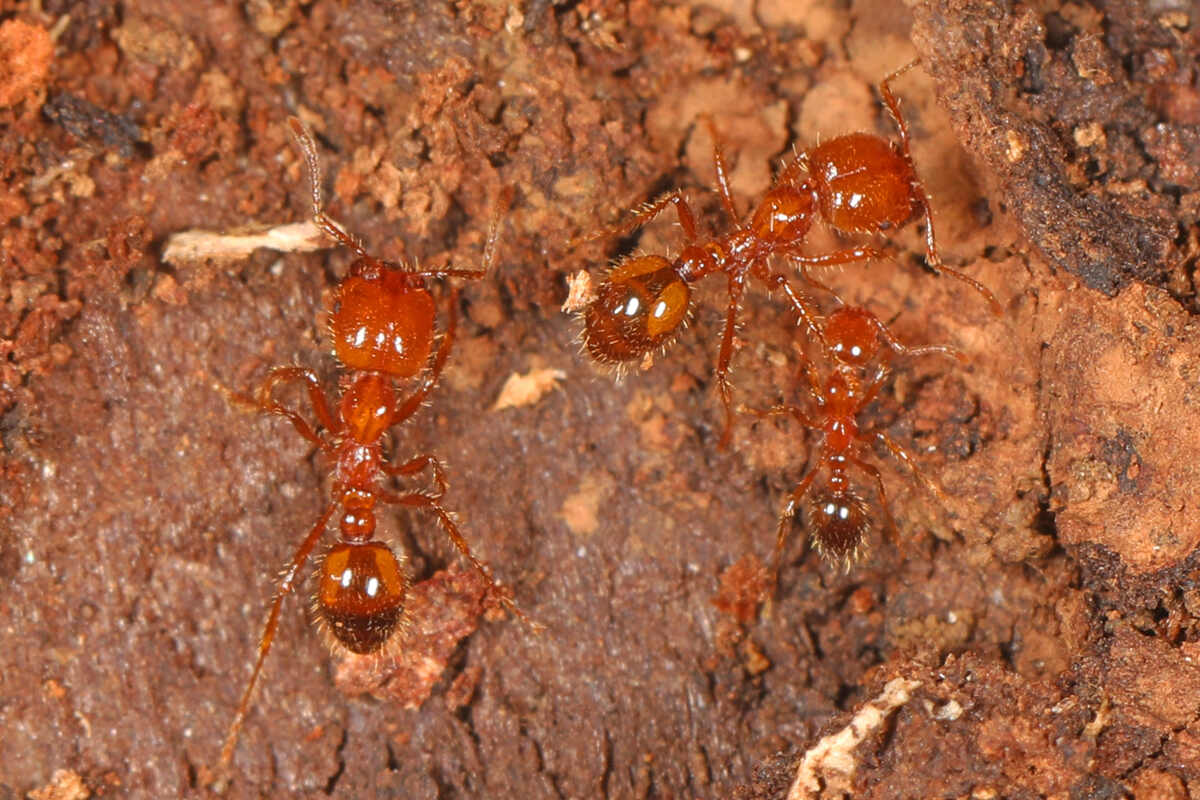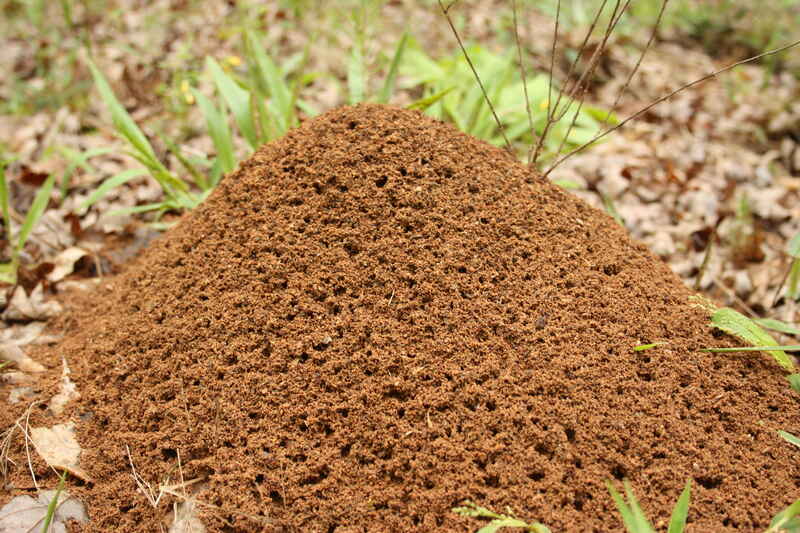
Fire ants are a menace in Southern lawns. To get rid of fire ants, boil some water and pour it directly on each mound. For long-term control, spread bait across the whole yard, then treat the mounds individually.
We’ll discuss other effective ways to get rid of fire ants in your yard and talk to a university extension expert to help take back your yard from these invasive pests.
Where to Find Fire Ants
Imported fire ants came to the southern U.S. from South America. With no natural enemies, their range continues to expand across the South, where their colonies grow rapidly. Although they cause painful and sometimes life-threatening bites to humans and pets, by using the simple strategies we’ll explain below, you can control fire ants and protect your home and family.

Bait and Drench Method
The best way to get rid of fire ants in your yard is the two-step method (sometimes called the Texas Two-Step), which uses bait and mound drenches to eliminate your pest problem.
Step 1: Broadcast Bait Across the Yard
The first part of the two-step method is to apply a bait product over your whole lawn for long-term fire ant control. Baits are granules made of an insecticide packed inside an attractant, such as soybean oil.
Here’s how the broadcasting step works:
- Wait for a clear, dry day in late afternoon or evening when ants actively forage. You don’t want rain to immediately wash away the granules you’ve broadcasted around your yard.
- “Always read the label before using any pesticide,” says Shaku Nair, entomologist and associate in Extension at the Arizona Pest Management Center. Label instructions inform you of safety precautions and how to correctly apply your specific product to your lawn.
- Use a handheld seed spreader or broadcast spreader to spread the bait evenly around your entire yard. “Foraging ants pick up the bait and take it into the mounds, where they share it with other ants and thus larger numbers are reached,” Nair says.
- Once the colony has ingested the bait, including the queen, it will eventually kill off the ant colony for effective long-term control.
Why use baits? Baits, rather than sprays, are more effective for fire ant control, Nair says.
“Spraying an area with pesticides is not helpful because the sprays only reach ants that are trailing outside of the mounds, whereas there may be huge numbers of ants inside the mounds where no spray can reach.”
On average, the two-step treatment method may take 2 weeks or up to 4 months to achieve 90% eradication of the fire ants, says Nair. She explains that the time it takes to treat fire ants depends on multiple factors, including:
- Species of fire ant
- Population size
- Time of year
- The type of pesticide product
When to apply: Baits are usually broadcast in the late spring when the soil surface temperature reaches 70-90 F and fire ants are actively foraging for food. Otherwise, the fire ants won’t carry the granules to their nests, and the chemical will sit in your yard.
To know whether the ants are actively foraging, try this simple test: Place a small amount of bait or another tasty treat (potato chip or hot dog) next to the nest. If the ants have found the food within half an hour, it’s an ideal time to treat.
However, if a fire ant infestation continues to thrive throughout the summer, you can apply bait again in late summer or early fall.
Pro Tip: “Different species of fire ants construct different types of mounds,” explains Nair. But here’s a tell-tale sign of a fire ant mound: Unlike the mounds of other ants, fire ant mounds don’t have holes on top. Also, fire ants are most active from spring to fall on sunny days with warm temperatures of 65 F or higher.
See Related:
Step 2: Drench the Mounds

Step 1 provides long-term control, but the purpose of Step 2 is to quickly treat and eliminate fire ant mounds in areas that people or pets frequent. Consider treating mounds around the foundation of your home or around driveways, sidewalks, or electrical boxes or fixtures (like outside lights) to keep your home safe.
The second step is more labor-intensive and the ant mounds need to be regularly monitored. Here’s how to treat each mound individually with either liquid or granular pesticides:
- Wait until the late afternoon or evening when the ants are actively foraging.
- Drench the mound with a liquid, dust, or granular pesticide. This usually takes 1-2 gallons of liquid pesticide or a generous layer of granules. Some granular pesticides need to be watered to take effect, so read the label for directions.
- After an application, move away from the ant hill quickly to avoid being bitten.
Individual mound treatments usually kill off a colony within a few days.
Remember, the two-step method is a process that will get rid of fire ants in your yard, but it is not a form of pest prevention. Even after you have treated your lawn, there’s a possibility that other fire ants will move in and start a colony again in your yard.
Attention Pet Owners: Before you let your pets onto the treated area, thoroughly water the areas where granular, liquid, or dust pesticides have been applied, and allow them to dry. Always follow safety precautions on the label.
Alternatively, consider the natural mound treatments in the next section.
How to Get Rid of Fire Ants Naturally
Natural remedies such as natural ant bait, boiling or soapy water, diatomaceous earth, and citrus oils can be used as broadcast or mound treatments for fire ants.
Natural Ant Bait
For an effective, chemical-free approach, use the two-step method but with natural products. Look for organic fire ant pesticides that contain spinosad, a biopesticide that comes in liquid drenches and baits.
Spinosad bait treatments usually work within 2 to 3 weeks. Liquid drenches kill by contact (immediately), so drenching the mound with enough solution is key. For small mounds, 1 gallon of the drench solution is usually sufficient, but you may need to apply 2 or more gallons of the solution to large mounds.
Boiling Water
One simple home remedy is to boil water and pour it over the ant hill. This fire ant killer is convenient because you don’t have to buy supplies or chemicals.
Here’s how the boiling water method works:
- Wait for a time when fire ants are close to the surface. After a heavy rain or on a sunny, cool morning is a good time.
- Boil about 3 gallons of water on the stove.
- Quickly pour the boiling water onto the mound.
- Move away from the spot immediately. Angry ants might come out to attack, so keep your distance to avoid being bitten.
Boiling water is the cheapest organic method for killing fire ants and is successful about 60% of the time. This method is good for killing worker ants, but it isn’t as good at reaching the queen since she lives deep inside the nest. However, using at least 3 gallons of water will increase the chance you’ll successfully reach the queen and eliminate the colony.
If a portion of the colony survives, however, it may simply relocate elsewhere in your yard.
Diatomaceous Earth
Diatomaceous earth (DE) may be effective at killing individual ants, but whether it can eliminate a whole colony is debatable. However, if you want to give it a go, here’s how to do it:
To use diatomaceous earth, sprinkle it over active sites where ants travel so they can come into contact with it.
Here’s how it works: When ants brush up against diatomaceous earth, it cuts their exoskeleton. Eventually, this causes them to die of dehydration. Opt for food-grade DE when using this method.
Soapy Water
A water and soap solution can be used as a fire ant killer, as research shows that it succeeds about 60% to 70% of the time. However, as with boiling water, if only a portion of the colony is killed, the remaining ants may move to another area of the lawn.
Here’s how to fight ants with soapy water:
- Mix 1 tablespoon of dish soap in 1 quart of water in a bottle or a bucket.
- Drill a hole in the ant hill. You can use a screwdriver, stick, or other thin tool to help poke a hole in the ant mound.
- Pour the soap mixture inside the mound. Time it so that you apply the soapy water mixture when it is late in the evening. By that time, most of the ants should be inside the mound.
- Pour the remaining mixture into a spray bottle.
- Then squirt the spray onto ants around the nest or on areas with heavy ant traffic.
- Repeat this procedure multiple times. It will take multiple applications before it takes effect.
Citrus
Citrus oils contain a component called D-limonene that is toxic to fire ants and can work as a fire ant pesticide.
To make a pesticide using D-limonene, mix these ingredients together in a bucket:
- 1/3 cup of commercial-grade D-limonene
- A good squirt of dish soap
- 5 gallons of water
Once you have your mixture, drench the ant mound in the D-limonene mixture. D-limonene is a good contact pesticide for fire ants that is about as effective as using boiling water.
When to Call a Professional
If your fire ant infestations persist or you have a large property with many ant mounds, save yourself the hassle and hire a pest control company. Left untreated, fire ant colonies can grow up to hundreds of thousands of worker ants, which is far too many to deal with on your own.
Ready to Be Rid of Your Fire Ant Problem?

When fire ants invade your lawn, you can get rid of them by using the two-step method or natural home remedies. While these treatments have varying degrees of effectiveness, it’s important to find a solution that works for you and your yard.
If treating your lawn on your own sounds intimidating, LawnStarter customers can get professional fire ant treatment at the click of a button online or in the app or by calling Customer Service. A local pro will save you both the time and the hassle required to treat fire ants.
Sources:
- “Ant Pests: Are There any Home Remedies That Will Kill Fire Ants?” National Cooperative Extension.
- “Fire Ant Control in Two Easy Steps.” By Kelly Loftin, associate professor and Extension entomologist, and John Hopkins, assistant professor and Extension entomologist. University of Arkansas.
- “Fire Ant Control Methods Around Pets.” By Paul Nester, Extension program specialist – integrated pest management. Texas A&M AgriLife Extension.
- “Lessons Learned from Farmers: Fire Ant Control.” By Molly Jameson, Extension agent. UF IFAS Extension.
- “Managing Imported Fire Ants in Urban Areas.” By Bastiaan Drees, entomology expert, et al. University of Florida.
- Organic Fire Ant Control. By Blake Layton, Extension professor and entomologist. Mississippi State University Extension.
- Shaku Nair, associate in Extension, community IPM at the University of Arizona, Tucson, AZ. Personal interview.
- “The Texas Two-Step Method.” By Michael Merchant, Extension urban entomologist, and Bastiaan Drees, Extension entomologist and fire ant project coordinator. Texas A&M University.
- “Two-Step Method.” Texas A&M AgriLife.
Main Image: Fire ants. Image Credit: Judy Gallagher / Flickr / CC BY 2.0